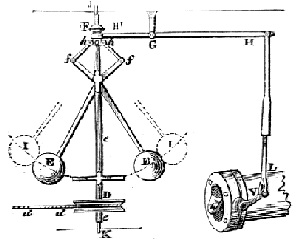The centrifugal governor was yet used in windmills (please see the photo), in former times (prior to Watt's age).
The use of this ingenious device was the adjustement of the distance between the bedstone and the runner stone, this distance changes as changes the windmill rate.
The miller had to manually made the regulation by a lever, after someone (a genius) introduced this wonderful device:
The governor, which automatically adjusts the distance between bedstone and runner stone.

In 1787 Watt adopted the centrifugal governor and after it was named "Watt's governor".
The application of this device to the steam engine has a great importance in the technology history because it was the founder of a great family of devices for the installations automatic control.
If the engine gained excessive speed, centrifugal force drove the balls and the balls the steam valve. The engine then slowed.
Please see below.
The governor used two heavy balls (E), mounted on swinging arms (f). The arms was connected to regulate the steam valve (V).
The whole assembly was geared to rotate with the engine's motion.
It was also set to maintain the motion at the desired speed.
If the engine gained excessive speed, centrifugal force drove the balls outward in wider circles. This moved the arms. The arms choked down the steam valve, thereby reducing speed.
If the engine lagged the balls lowered and admitted more steam.
